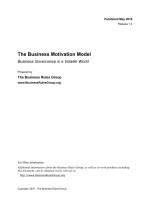leadership for the common good tackling public problems in a shared-power world
Bạn đang xem bản rút gọn của tài liệu. Xem và tải ngay bản đầy đủ của tài liệu tại đây (2.86 MB, 492 trang )
TeAM
YYeP
G
Digitally signed by
TeAM YYePG
DN: cn=TeAM
YYePG, c=US,
o=TeAM YYePG,
ou=TeAM YYePG,
email=yyepg@msn.
com
Reason: I attest to the
accuracy and integrity
of this document
Date: 2005.06.30
05:36:17 +08'00'
Leadership for the Common Good
Leadership for the
Common Good
Tackling Public Problems
in a Shared-Power World
Second Edition
Barbara C. Crosby
John M. Bryson
Copyright © 2005 by John Wiley & Sons, Inc. All rights reserved.
Published by Jossey-Bass
A Wiley Imprint
989 Market Street, San Francisco, CA 94103-1741 www.josseybass.com
No part of this publication may be reproduced, stored in a retrieval system, or transmitted
in any form or by any means, electronic, mechanical, photocopying, recording, scanning,
or otherwise, except as permitted under Section 107 or 108 of the 1976 United States Copy-
right Act, without either the prior written permission of the Publisher, or authorization
through payment of the appropriate per-copy fee to the Copyright Clearance Center, Inc.,
222 Rosewood Drive, Danvers, MA 01923, 978-750-8400, fax 978-750-4470, or on the web at
www.copyright.com. Requests to the Publisher for permission should be addressed to the
Permissions Department, John Wiley & Sons, Inc., 111 River Street, Hoboken, NJ 07030,
201-748-6011, fax 201-748-6008, e-mail:
Jossey-Bass books and products are available through most bookstores. To contact Jossey-
Bass directly call our Customer Care Department within the U.S. at 800-956-7739, outside
the U.S. at 317-572-3986 or fax 317-572-4002.
Jossey-Bass also publishes its books in a variety of electronic formats. Some content that
appears in print may not be available in electronic books.
Library of Congress Cataloging-in-Publication Data
Crosby, Barbara C., 1946–
Leadership for the common good : tackling public problems in a
shared-power world / Barbara C. Crosby, John M. Bryson 2nd ed.
p. cm.
Bryson's name appears first on the earlier edition.
Includes bibliographical references and index.
ISBN 0-7879-6753-X (alk. paper)
1. Leadership. 2. Political leadership. 3. Common good. 4. Public
administration. I. Bryson, John M. (John Moore), 1947– II. Title.
JF1525.L4B79 2005
303.3'4 dc22
2004025833
Printed in the United States of America
FIRST EDITION
HB Printing 10987654321
Contents
Preface xiii
Acknowledgments xxv
The Authors xxix
Part One: Understanding Leadership
in Shared-Power Settings 1
1 When No One Is in Charge: The Meaning
of Shared Power 3
2 Leadership Tasks in a Shared-Power World:
Leadership in Context, and Personal Leadership 34
3 Leadership Tasks in a Shared-Power World:
Team and Organizational Leadership 64
4 Leadership Tasks in a Shared-Power World:
Visionary, Political, and Ethical Leadership 108
5 Policy Entrepreneurship and the Common Good 156
Part Two: The Process of Policy Entrepreneurship 195
6 Forging an Initial Agreement to Act 197
7 Developing an Effective Problem Definition
to Guide Action 216
8 Searching for Solutions in Forums 242
9 Developing a Proposal That Can Win in Arenas 267
10 Adopting Policy Proposals 290
11 Implementing and Evaluating New Policies,
Programs, and Plans 312
vii
12 Reassessing Policies and Programs 340
Summary and Conclusion 359
References 365
Resource A: Conflict Management 393
Resource B: A Guide to Oval Mapping 395
Resource C: Seven Zones 399
Resource D: Forums, Arenas, and Courts 401
Resource E: Future Search 427
Resource F: Initial Policy Retreats 433
Name Index 437
Subject Index 445
viii C
ONTENTS
List of Exhibits
Exhibit 1.1. Tackling Public Problems in a Shared-Power
World: Some Definitions 22
Exhibit 5.1. Policy Entrepreneurship and the
Common Good: Some Definitions 158
Exhibit 6.1. Characteristics of Effective Coordinating
Committees and Other Policy-Making Bodies 209
Exhibit 7.1. Generic Problem Statement Format 238
Exhibit 11.1. Guidance for Pilot Projects, Demonstration
Projects, and Transfer to Entire
Implementation System 337
Exhibit D.1. The Three Dimensions of Power 402
Exhibit D.2. Designing and Using Forums 410
Exhibit D.3. Designing and Using Arenas 416
Exhibit D.4. Designing and Using Courts 421
ix
List of Exercises
Exercise 1.1. Understanding Public Problems in a
Shared-Power World 21
Exercise 2.1. Discovering Cares and Concerns 38
Exercise 2.2. Assessing the Context for Leadership 43
Exercise 2.3. Assessing Global Trends 45
Exercise 2.4. Assessing Cultural Differences 48
Exercise 2.5. Exploring Personal Highs and Lows 50
Exercise 2.6. Assessing Additional Strengths and
Weaknesses 60
Exercise 2.7. Analyzing Social Group Membership
and Means of Bridging Differences 62
Exercise 3.1. Using “Snowcards” to Identify and Agree
on Norms 72
Exercise 3.2. Assessing Your Team 78
Exercise 3.3. Stakeholder Identification and Analysis 83
Exercise 3.4. Mission Development 85
Exercise 3.5. Constructing an Organizational Vision
of Success 88
Exercise 3.6. Assessing Your Organization 103
Exercise 4.1. Outlining and Constructing Personal Visions 116
Exercise 4.2. Using a Power-Versus-Interest Grid 121
Exercise 4.3. Analyzing Interpretive Schemes,
or Problem Frames 124
Exercise 4.4. Assessing Visionary Leadership Capacity 130
Exercise 4.5. Laying the Groundwork for a
Winning Coalition 137
Exercise 4.6 Assessing Political Leadership Capacity 144
xi
Exercise 4.7. Identifying Ethical Role Models, and
Overcoming Barriers to Ethical Leadership 147
Exercise 4.8. Analyzing Ethical Principles, Laws,
and Norms 152
Exercise 4.9. Assessing Ethical Leadership Capacity 153
Exercise 5.1. Thinking About a Public Problem 166
Exercise 5.2. Thinking About the Public Interest and
the Common Good 191
Exercise 6.1. The Basic Stakeholder Analysis Technique
for a Policy Change Effort 203
Exercise 6.2. Constructing a Stakeholder Influence
Diagram 204
Exercise 6.3. Participation Planning Matrix 204
Exercise 6.4. Assessing Stakeholder Attitudes Toward
the Status Quo 211
Exercise 7.1. Developing Objectives from Preferred
Solutions for a Problem 233
Exercise 7.2. Constructing a Diagram of Bases of Power
and Directions of Interest (Goals) 234
Exercise 7.3. Constructing a Map of the Common Good
and Structure of a Winning Argument 235
Exercise 8.1. Undertaking a Solution Search Within
Specified Areas 254
Exercise 8.2. Constructing a Stakeholder-Issue
Interrelationship Diagram 257
Exercise 8.3. Using a Multicriteria Assessment Grid 259
Exercise 9.1. Pursuing a Big-Win or a Small-Win Strategy 276
Exercise 9.2. Constructing a Stakeholder-Support-Versus-
Opposition Grid 283
Exercise 9.3. Conducting a Stakeholder Role Play 284
Exercise 9.4. Constructing a Grid of Policy Attractiveness
Versus Stakeholder Capability 285
Exercise 11.1. Tapping Stakeholder Interests and
Resources for Policy Implementation 327
xii L
IST OF
E
XERCISES
Preface
Our world is so complex, interdependent, and interrelated
that the old paradigms of singular leadership will not
work and cannot work.
S
UZANNE
W. M
ORSE
Remember that leaders come in both genders, all sizes,
[all] ages, [and] from all geographic areas and
neighborhoods.
M
ARIAN
W
RIGHT
E
DELMAN
Several times over the last few years, we’ve asked ourselves about
our own call to leadership in a world beset by unprecedented chal-
lenges and crises, from the AIDS pandemic to global warming to
the destruction and fear wrought by terrorism and state responses
to it. We have joined particular initiatives to respond to these chal-
lenges, but we always return to the conviction that our best con-
tribution is teaching and writing about how the world’s citizens can
work together for the common good in their organizations and
communities.
In particular, we realized it was high time to respond to the
many users of the original Leadership for the Common Good who asked
for more practical guidance in how to lead in a shared-power en-
vironment, and for more recent and varied examples of how oth-
ers are striving to achieve the common good. The new Leadership
for the Common Good is our effort to update and make our leader-
ship framework more accessible to a variety of audiences, to con-
nect it with the challenges of the twenty-first century, and to draw
on the best of recent research on leadership and public problems.
We take heart (and guidance) from the many other leadership
scholars and practitioners who also have turned their attention to
the importance of shared leadership and the need for collaboration
xiii
among diverse groups during recent years. It’s common now to
hear that leadership can and should be exercised by people with
many kinds of formal and informal authority and responsibility.
Leadership analysts and educators in many parts of the world are
preaching openness to more diverse leaders by agreeing with Mar-
ian Wright Edelman (1993) that leaders come from a multiplicity
of backgrounds.
We began our original book by noting that today’s citizens live
in a world where no one is in charge, where the needed resources
for coping with most important public problems extend well be-
yond the capacity of any group or organization, and often beyond
the scope of national governments. To make progress in tackling
those problems, people in a variety of roles—from citizen to elected
official, from business executive to nonprofit advocate, from edu-
cator to public manager—must take on the leadership challenge
of building shared-power arrangements of lasting value.
What was true a decade ago is even truer now. We agree with
Suzanne Morse (1991) that singular models of leadership don’t
match the needs of the twenty-first century. Shared and widespread
leadership is required for dealing with the effects of global com-
plexity and interdependence, from economic shifts to climate
change to terrorism. The same is true for remedying problems that
might seem to be local or national: AIDS, homelessness, rural out-
migration, urban brownfields, drug abuse, domestic violence, and
a host of other public problems.
Many individuals, groups, organizations, and institutions have
a stake in each of these problems. They are directly affected, or
have some responsibility to act on the problem, or have informa-
tion or other resources necessary to make improvements; yet each
of these stakeholders has only some of the information, resources,
and authority needed to remedy the problem. They operate in a
“shared-power world,” a world in which they must share objectives,
activities, resources, or authority to achieve collective gains or min-
imize losses (Bryson and Einsweiler, 1991; Healey, 1997; Peters,
1996a, 1996b; Bardach, 1998).
Achieving beneficial policy change in such a world requires
heroic individuals, groups, and organizations (Kennedy, 2002) but
also quiet or invisible leaders (Sorenson and Hickman, 2002;
Badaracco, 2002; Mintzberg, 2002). To make headway, leaders and
supporters have to work with great persistence, often over a long
xiv P
REFACE
period of time to institute new policy regimes and often dismantle
old ones. These leaders have to be what Nancy Roberts and Paula
King (1996) call policy entrepreneurs.
The second edition of Leadership for the Common Good offers pol-
icy entrepreneurs a wealth of practical guidance grounded in the
most recent research about leadership effectiveness. The book also
highlights important new contributions of leadership and public
policy theorists. We draw extensively on four new minicases of lead-
ership for the common good, and each chapter includes exercises
to help you the reader apply concepts and tools to your own lead-
ership cases. The original single chapter on leadership capabilities
has been expanded to three chapters, and we have added a sub-
stantial section (in Chapter Five) on the common good. Greater
attention is given to the methods and tools of stakeholder in-
volvement in public policy change efforts.
The minicases focus on (1) the early campaign against AIDS;
(2) the work of the World Business Council for Sustainable Devel-
opment; (3) the African American Men Project in Hennepin
County, Minnesota; and (4) development of the Vital Aging Net-
work, a pioneering initiative based at the University of Minnesota.
Of necessity, we mention by name only a handful of the leaders
connected to each case but recognize that we could have men-
tioned many, many more.
We concede that shared-power arrangements can be used to
thwart change for the common good; indeed, we cite examples in
which such arrangements slowed the fight to stop the spread of
AIDS. In the face of this reality, we offer practical and ethical ar-
guments for doing otherwise. Those who ignore the well-being of
their fellow humans in today’s interdependent world risk damage
to their own groups in the long run. We also think that all human
endeavors, including leadership, should be judged on ethical
grounds; that is, they should promote widely held principles such
as human dignity and equal opportunity (Crosby, 1999).
Who Should Read This Book?
We assume you’re reading this because you want to do something
about an issue, improve your organization or your community, or
make the world a better place. You are seeking to match your pas-
sions and skills with significant social needs.
P
REFACE
xv
This book is for people around the world who care about gov-
ernance and policy change, people providing formal and informal
leadership in nonprofit organizations, government agencies,
elected office, businesses, schools and universities, foundations, and
mass media. It is for the seasoned veteran of the world of public af-
fairs as well as the citizen who is just getting involved in community
issues. It is for those who want to be change agents and catalysts,
reshapers of old arrangements and midwives for new ones. It is
for those who want to operate effectively across organizational or
jurisdictional boundaries, understand power and shared-power
arrangements, and wrestle with public issues so the common good
can be achieved.
We also present concepts, tools, and guidance that can be useful
to those who educate or support community activists, public admin-
istrators, policy analysts, elected officials, and nonprofit and business
executives and managers. The book should be useful as a text for
university courses in leadership, public affairs, public administra-
tion, planning, and public policy. It can also be a resource for com-
munity educators, organizational consultants, and researchers.
We offer our leadership framework to people seeking to pro-
mote significant policy change and community reform in a demo-
cratic context, even as we recognize that an understanding of how
policy change really occurs can at least temporarily aid those who
wish to thwart democratic action. The framework offers promising
possibilities for democratic citizenship and change by drawing crit-
ical attention to what often remains hidden or assumed, enumer-
ating and naming access points for influencing policy and
highlighting the moments of change in a shared-power world. In-
deed, revealing the dynamics of shared power makes democratic
change more likely, because wider awareness means many more
people know how to join the action and forestall abuses of power.
As former Vice President Hubert Humphrey observed, “Democ-
racy is based on the premise that extraordinary things are possible
from ordinary people.” We hope our leadership framework con-
tributes to the continuous regeneration of a democratic, just, free,
and sustainable world.
We acknowledge legitimate skepticism about such terms as
democracy and the common good. Although we recognize that the
common good necessarily embraces some moral principles, we are
xvi P
REFACE
definitely not endorsing any predetermined, unified, rigid vision
of the common good. We also recognize that democracy is a means
as well as an end; in the hope of being relevant for diverse societies,
we are not committed to a particular mode of democratic govern-
ment and are well aware that any form of government can easily
take on antidemocratic methods.
Can the book be useful to people living under an authoritar-
ian government? We think it can and must be. There are always
free spaces in which to work; witness the overt and covert citizen
activism that contributed to the downfall of the USSR and of the
apartheid regime in South Africa. Witness the recent progress,
however uneven, of democratic forces in Iran.
Where Do Our Ideas Come From?
Our attempt to understand leadership in today’s shared-power
world is part of a worldwide intellectual endeavor. Over the last
dozen years, other authors have made valuable contributions
through books exhorting and guiding ordinary citizens to act
courageously, claim their power, and demand decision-making au-
thority over policies and programs that affect them (Sirianni and
Friedland, 2001; Boyte and Kari, 1996; Daloz, Keen, Keen, and
Parks, 1996; Loeb, 1999; Roy, 2001). Several of these writers also
ask professionals to use their expertise in a fashion that empowers
fellow citizens rather than objectifying and alienating them.
Other authors offer new guidance for elected officials and pub-
lic managers, for nonprofit groups, and for businesspeople who want
to lead innovative and responsible companies—for example, Jean
Lipman-Blumen’s Connective Leadership (1996), Jeff Luke’s Catalytic
Leadership (1998), Kathleen Allen and Cynthia Cherrey’s Systemic
Leadership (2000), Robert Terry’s Seven Zones for Leadership (2001),
Donald Kettl’s Transformation of Governance (2002), and James Mac-
Gregor Burns’s Transforming Leadership (2003). A literature has de-
veloped on public deliberation and consensus building (Innes, 1994;
Roberts, 2002; Susskind, McKearnan, and Thomas-Larmer, 1999);
alternative dispute resolution (Thompson, 2000); governance as
relationship in contrast to principal-agent theory (Feldman and
Khademian, 2002); collaboration (Innes, 1994; Healey, 1997; Mar-
garum, 2002; Ray, 2002; Huxham, 2003); and advocacy coalitions
P
REFACE
xvii
(Sabatier and Jenkins-Smith, 1993). Some of this new literature con-
tributes to the notion of policy entrepreneurship (Roberts and King,
1996; Henton, Melville, and Walesh, 1997; Osborne and Plastrik,
1997; see especially Krieger, 1996). Helpful research and theory
building have also been published in periodicals such as The Lead-
ership Quarterly, the Journal of Leadership and Organizational Studies (for-
merly the Journal of Leadership Studies), and Leader to Leader as well as
in proceedings of International Leadership Association conferences.
In this book we try to pull together these contributions, along
with the insights we’ve gained in the last decade as we helped oth-
ers use the Leadership for the Common Good framework. Since
publication of the first edition of Leadership for the Common Good,
we’ve used the framework in classes, workshops, and consultations
in the United States, the United Kingdom, and Eastern Europe.
Participants in these sessions have ranged from college under-
graduates to midcareer professionals from around the world. They
have helped us develop and refine our ideas and methods and thus
contributed indirectly to this book and others, especially Strategic
Planning for Public and Nonprofit Organizations, Third Edition (Bryson,
2004a) and Leadership for Global Citizenship (Crosby, 1999). In re-
cent years our own research has concentrated on use of the Lead-
ership for the Common Good framework in diverse settings, on
use of specific tools and methods to help groups achieve their
goals, and on leadership education.
Our main goal in writing this book is to help ordinary citizens,
elected officials, business people, nonprofit activists, and public
managers work with diverse stakeholder groups to develop and
implement new regimes of mutual gain—that is, policy regimes
serving the common good. We present the theoretical underpin-
nings of our framework, along with considerable guidance for
putting it to use.
What Is the New Leadership for the Common Good?
Most writing about leadership, even the most recent spate, focuses
on individual development and efficacy, or on organizational per-
formance. Much of this writing deepens the understanding of how
individuals develop leadership passions and capabilities, how they
learn, and how they can (and sometimes fail to) serve others while
xviii P
REFACE
caring for themselves. A few leadership scholars focus on inter-
organizational leadership and policy change; examples are Jeffrey
Luke (1998), Siv Vangen and Chris Huxham (Huxham and Vangen,
2000; Vangen and Huxham, 2003), and David Chrislip and Carl
Larson (1994). Additionally, multiple contributions have emerged
from the growing body of research into modes of organizational
leadership suited to the complex, networked, fast-moving social en-
vironment of the early twenty-first century (Wheatley, 1999; Allen
and Cherrey, 2000; Terry, 2001; Drath, 2001; Brown and Gioia,
2002; Gronn, 2002; Nelson, Kaboolian, and Carver, 2003). Mean-
while, scholars and practitioners continue to refine analysis of pol-
itics, public policy, social innovation, and citizenship. We attempt
to bring these strands together in a comprehensive, dynamic ap-
proach that offers practical guidance for leadership, which we de-
fine as inspiring and mobilizing others to undertake collective action in
pursuit of the common good.
The new Leadership for the Common Good framework em-
phasizes the importance of eight leadership capabilities:
1. Leadership in context: understanding the social, political,
economic, and technological givens
2. Personal leadership: understanding self and others
3. Team leadership: building effective work groups
4. Organizational leadership: nurturing humane and effective
organizations
5. Visionary leadership: creating and communicating shared
meaning in forums
6. Political leadership: making and implementing decisions in
legislative, executive, and administrative arenas
7. Ethical leadership: adjudicating disputes in court and sanc-
tioning conduct
8. Policy entrepreneurship: coordinating leadership tasks over
the course of a policy change cycle
These capabilities are rooted in a model of power, a model of pol-
icy change, and an approach to the common good. We emphasize
the importance of stakeholder analysis and involvement through-
out policy change efforts. Although we offer a general framework
that should apply across contexts, we also recognize the need for
P
REFACE
xix
specific adaptations of the framework in differing contexts—a need
emphasized by a recent Harvard University Leadership Roundtable
chaired by Ronald Heifetz and Philip Heyman (Pruyne, 2002).
The new edition of Leadership for the Common Good presents an
overview of the complex fields of leadership and policy change, and
although it gives practical guidance it does not present a simple
recipe or cookbook. Instead, we seek to offer what Chris Huxham
calls “handles for reflective practice” (Huxham, 2003, p. 420). We
are guided by the wisdom of Albert Einstein, who said, “Things
should be made as simple as possible, but no simpler.”
In a very real sense this book is about planning, if planning is
viewed as what Stephen Blum calls “the organization of hope”
(Forester, 1989, p. 20; Baum, 1997). Planning, in other words, is
what makes hope reasonable. The planning process in a shared-
power situation, however, is quite different from the process many
organizational theorists have recommended. Planning in a shared-
power situation hardly ever follows a rigidly structured sequence
from developing problem definitions and solutions to adopting
and implementing proposals. Serious difficulties arise when peo-
ple try to impose any rigidly sequential approach on a situation in
which no one is in charge. Nonetheless, to be steadily effective,
leaders must have an organized approach of some sort (Abramson
and Lawrence, 2001). Their challenge is to instill political, techni-
cal, legal, and ethical rationality into these difficult situations; that
is, they must effectively link knowledge to action (Friedmann,
1987). Therefore, we describe the kind of procedural rationality that
can be used to effectively address substantive public problems, and
we define the conditions and leadership actions that will support
this rationality (March and Simon, 1958; Stone, 2002).
The new Leadership for the Common Good is chiefly concerned
with enhancing practice; it draws on and develops theory in the ser-
vice of practice. The four minicases highlighted in this book are
used mainly to illustrate elements of the Leadership for the Com-
mon Good framework. At the same time, our study of the cases has
enriched the framework and the guidance we offer for applying it.
We have been personally involved in the African American Men
Project and the Vital Aging Network as action researchers and ed-
ucators. Our research on the AIDS and World Business Council
cases draws mainly on secondary sources. We selected these cases
xx P
REFACE
because they involve complex public problems (AIDS, global
warming, and social exclusion) that affect communities around the
world, and because they involve policy entrepreneurs from busi-
ness, government, and the nonprofit or voluntary sectors. If you
want to update yourself on what has become a global campaign
against AIDS, we suggest consulting . Up-
dated information about the World Business Council for Sustain-
able Development may be found at , for the
African American Men Project at , and
for the Vital Aging Network at .
Outline of Chapters
Part One is devoted to understanding leadership in a shared-power
setting.
Chapter One introduces the idea of a shared-power world with
no one in charge and contrasts two organizational forms: hierarchy
and networks. In hierarchical organizations, someone or a small
group is recognized as being in charge, whereas in a network of or-
ganizations and individuals many people are partly responsible for
acting on important public problems and must share power if they
are to find and implement effective remedies for the problems. The
chapter also contrasts the rational planning model with the politi-
cal policy-making model of the shared-power world and explains
the importance of developing a new appreciation of public prob-
lems and potential solutions. Shared power and shared-power
arrangements are defined and their causes and consequences are
discussed, leading to a call for leadership for the common good. Fi-
nally, we introduce the four examples of public problem solving
that are used throughout the book to illustrate our points. The cam-
paign to eradicate AIDS highlights the need for leadership at many
levels, from local to supranational. The work of the World Business
Council for Sustainable Development highlights networking among
business executives, and among these executives and multiple stake-
holder groups to build support for environmental protection cou-
pled with economic growth. The African American Men Project,
sponsored by elected officials in Hennepin County, Minnesota,
highlights collaborative leadership by public officials and commu-
nity partners, and the Vital Aging case highlights a university-based
P
REFACE
xxi
response to a major demographic change, the “graying” of the baby
boom generation.
Chapters Two, Three, and Four describe the eight key leader-
ship capabilities in a shared-power world. Chapter Two focuses on
leadership in context and on personal leadership; Chapter Three
focuses on team and organizational leadership. Chapter Four ex-
plores visionary, political, and ethical leadership and the shared-
power settings associated with them (respectively, forums, arenas,
and courts). The design and use of these settings affects dramati-
cally how public issues are framed and how public policies can deal
with them. We tie these settings to a holistic view of power.
Chapter Five outlines the policy change process in shared-
power settings and links the process to the common good. The
process, or cycle, comprises seven phases played out as intercon-
nected activities with shifting purposes and actors in shifting fo-
rums, arenas, and courts. Policy entrepreneurship is the label we
give to the leadership work of navigating the policy change cycle.
Part Two elaborates the process of policy entrepreneurship.
Chapters Six through Twelve describe in detail how to work
through the policy change cycle. Each chapter describes one phase
of the cycle in terms of desired outcomes; benefits; the roles of fo-
rums, arenas, and courts; and leadership guidelines, with special
attention to stakeholder involvement. Chapters Six through Eight
together consider the process of creating public issues, which we
define as linked problems and solutions, and placing them on the
public agenda. Chapter Six covers the initial agreement to do
something about an undesirable condition, Chapter Seven ex-
plores the nature of public problems and presents a practical ap-
proach to formulating these problems so they can be addressed,
and Chapter Eight presents effective methods for developing so-
lutions or remedies that can ameliorate the problems. This chap-
ter also describes how the nature of issues affects the politics of
doing something about them.
Chapter Nine discusses proposal development, presents the
characteristics of winning proposals, and highlights the differences
between “big win” and “small win” solutions. Chapter Ten covers
proposal review and adoption. This phase requires a “coupling” of
change cycle elements: a recognized problem, a viable solution, a
favorable political climate, reduced barriers to effective action, and
xxii P
REFACE
a policy decision. Because political manipulation is involved, the
chapter also covers agenda control, strategic voting, and alteration
of an issue’s dimensions in order to build or break a coalition.
Chapter Eleven considers the process of policy implementation,
and Chapter Twelve concludes the detailed description of the pol-
icy change cycle with a discussion of policy maintenance, modifi-
cation, and termination.
Chapter Twelve also includes guidelines for getting started with
leadership for the common good. The book ends with five re-
source sections.
The new Leadership for the Common Good offers a comprehensive
approach to leadership as a shared-power phenomenon that em-
braces many individuals, organizations, and institutions. Our basic
premise is that sharing power to resolve public issues is a fortunate,
rather than unfortunate, necessity because it ensures that diverse
voices and needs receive attention, and that implementation of so-
lutions is more likely to succeed. Also, and fortunately, no one can
give direct orders and dictate terms in a shared-power world with
any assurance of compliance, but leaders do have many effective in-
direct methods at their disposal.
If the world’s people are to survive and prosper, and if our chil-
dren and grandchildren—and their children and grandchildren—
are to enjoy the benefits of our ability to make the world better, all
of us need ways to think and act more effectively in a shared-power
context. We must deepen our understanding of the interrelated
phenomena of power, change, and leadership.
P
REFACE
xxiii









